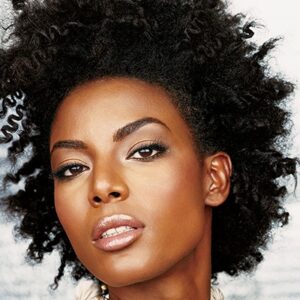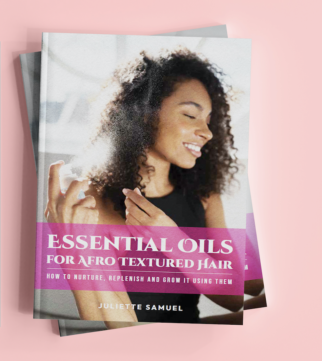 Make-up can be trans-formative: diminishing flaws or accentuating bone. However, those benefits can be matched by the challenges – especially for women of color – of finding make-up which best complements us amidst the ever-expanding cosmetics market.
Make-up can be trans-formative: diminishing flaws or accentuating bone. However, those benefits can be matched by the challenges – especially for women of color – of finding make-up which best complements us amidst the ever-expanding cosmetics market.
When you’re talking about African-American skin and makeup there is, of course, no ‘one size fits all’ solution, but we are going to take a look at some basic options if:
You are looking to create a natural finish (i.e, the ‘No Make-Up’ made-up look!)
You are trying to decide between make-up formulas: traditional, mineral and natural cosmetics
The ‘No Make-Up’ Made-up Look
If you’re one of those black women with even-toned, normal skin, full eyebrows and lush lashes, lucky you! Just press in a little yellow-toned powder, apply a swipe of eyebrow gel and a dab of lip gloss – and you’re done!
If, however, you’re like the rest of us, read on.
1) A natural finish starts with the preparation of the skin as the canvas for whatever comes next. What is your skin type?
- Dry? Apply a good hydrating moisturizer.
- Oily? Skip the moisturizer and apply a good primer – it will prevent your foundation from slipping.
- Combination? Deal with each area appropriately (e.g., primer on the oily T-zone; moisturizer on the drier areas).
2) Wait 10 minutes for your prep product(s) to sink in.
3) Do you need all-over foundation coverage or just on selected areas?
If you need all-over foundation, the best formulation for a natural look is:
- A liquid foundation applied with your fingers or a sponge
If you have hyperpigmentation or dark spots, you may require:
- A cream foundation applied by dotting sparingly, then blending with a damp sponge or warm fingers. (The damp sponge makes the finish more sheer.)
Remember to use small amount of product – you can always build up if you need more.
If you simply want to hide dark circles or a few blemishes, concealer alone may do the trick, but make sure you choose a creamy formulation and a shade that blends seamlessly into your skin tone (you may need two). Use sparingly with a concealer brush or beauty sponge for best results.
4) Set your foundation/concealer with a loose, finely-milled, yellow-toned powder. Forget so-called translucent powders. On black skin, they often look chalky – especially in flash-photography.
5) Eyebrows – groom brows with a spoolie and hold them in place with a good eyebrow gel. If your brows are sparse, fill in with a colored brow gel or pencil, using tiny brush strokes to replicate the appearance of brow hair. Use cool-toned brown or soft black pencils.
6) Lips – if your top and bottom lips are different colors, use a lip pencil to create matching tones, then finish with a touch of gloss. If your lips naturally match, try a lip stain or clear gloss.
7) Blusher – if your skin tone is very dark, skip the blusher. On mid to light tones, apply a light sweep of powder bronzer or an apricot blusher, starting from the ears, moving in to the face. NB cream blusher/bronzers are better for dry or older skins, and should be applied before setting the face with powder. (In general, leave the red, pink and burgundy shades for the more traditionally ‘done’ face.)
8) Eyes – to make your eyes pop, apply lengthening black mascara or clear mascara (if your lashes are very dark). Just one coat, though – remember, we’re all about looking natural! Leave the bottom lashes free of mascara.
Et voila!
Should I be Using Traditional, Mineral or Natural Make-up?
Here, there is no definitive answer; but below are the pros and cons of each option.
Traditional Make-Up
Pros:
- A wide choice of brands both at the pharmacy and in high-end department stores
- The best option for a full coverage, airbrushed make-up look
Cons:
- Invariably contains irritants such as talc, mica, bismuth oxychloride and fragrance
- Can degrade in six months – and should be replaced to avoid bacterial skin infections
- More likely to clog pores
Mineral Make-Up
A note: the ambiguous marketing of so-called mineral products has led to some confusion. Touted as ‘natural’, many – even most – mineral foundations and powders, are not natural at all, and contain nearly the same chemicals as traditional foundations and powders. Bismuth oxychloride, mica, titanium dioxide and zinc oxide can all be found in some brands of mineral make-up. (Bismuth oxychloride is a synthetically prepared powder which creates the white pigment that gives mineral make-up its trademark shimmery, silky finish.) Do read the fine print.
Pros:
- Typically non-comedogenic
- Water-resistant
- Lacks moisture and therefore lasts longer
- Now available in liquid form
- Absorbs oil well
- Less product gets the job done
- Recommended by plastic surgeons and dermatologists
Cons:
- More likely to settle in to fine lines and pores and accentuate dry, flaky skin
- Generally lighter in color, therefore darker-skinned women may have difficulty finding shades that match their skin tone
- More expensive than traditional make-up
- Just as likely to cause irritation (if it contains bismuth oxychloride, etc.) as traditional make-up
Natural Make-up
The newest ‘kid on the block’ and referred to as ‘natural mineral make-up’ or ‘organic make-up’. Look for labeling that reads: “Talc-free” or “Paraben-free”, or “100% All-Natural”.
Pros:
- Does not contain bismuth oxychloride
- Free of talc and cornstarch
- Contains no parabens or silicone
- Entirely plant-based, with herbals extracts; rich in vitamins; non-toxic
- Allows skin to breathe
Cons:
- Limited range/availability – especially for darker skin tones
- Expensive
My usual advice, when faced with all this choice is: “If it ain’t broke, don’t fix it.” But if your current make-up is causing breakouts, irritation or just making your face look gray, grab that make-up bag and head down to your dermatologist or beauty specialist for an inventory check. You might need just a tweak to your regimen to get that glowing natural finish you’ve been looking for.
This was a lot to take in this week, however, I hope you found the tips and techniques helpful. Until next time,
Dedicated To Your Beauty
Juliette Samuel
Esthetician/Author/Publisher
Nyraju Skin Care




 Facebook
Facebook Twitter
Twitter Delicious
Delicious Digg
Digg Myspace
Myspace StumbleUpon
StumbleUpon Youtube
Youtube